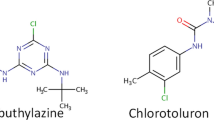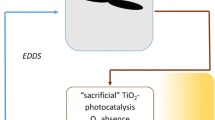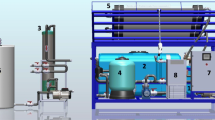Abstract
We have demonstrated the potential leaching of eight compounds, one insecticide (flonicamid) and seven fungicides (myclobutanil, penconazole, boscalid, difenoconazole, trifloxystrobin, pyraclostrobin and fenpyroximate) trough a typical Mediterranean soil (Calcaric regosol). The concentrations found in leaching water were in all cases above the limit set by the EU in groundwater (0.1 μg L−1). For this, the efficiency of different homogeneous (photo-Fenton and photo-Fenton-like) and heterogeneous (ZnO and TiO2) photocatalytic systems was tested in deionized water to choose the most appropriate treatment to remove pesticide residues from leaching water. The efficiency was in the order: ZnO + S2O82− (pH 7) > TiO2+ S2O82− (pH 7) > ZnO (pH 7) > TiO2 (pH 7) > Fe3+ (pH 3) > Fe3+ (pH 5) > Fe2+ (pH 3) > Fe2+ (pH 5). Thus, in the subsequent experiment we focus on the efficacy of solar heterogeneous photocatalysis (ZnO/Na2S2O8 and TiO2/ Na2S2O8) on their removal from leaching water. A fast removal was observed for all pesticides at the end of the photoperiod, noticeably higher in the case of ZnO system, with the exception of flonicamid, a recalcitrant pesticide where the degradation rate only reached about 20% after 240 min of solar exposure. Although the mineralisation of the initial dissolved organic carbon was not complete due to the presence of interfering substances in the leaching water, the conversion rate under ZnO/Na2S2O8 treatment was about 1.3 times higher than using TiO2/Na2S2O8.




Similar content being viewed by others
References
Adams LK, Lyon DY, Alvarez PJ (2006) Comparative eco-toxicity of nanoscale TiO2, SiO2, and ZnO water suspensions. Water Res 40:3527–3532. https://doi.org/10.1016/j.watres.2006.08.004
Ahmed S, Rasul MG, Brown R, Hashib MA (2011) Influence of parameters on the heterogeneous photocatalytic degradation of pesticides and phenolic contaminants in wastewater: a short review. J Environ Manag 92:311–330. https://doi.org/10.1016/j.jenvman.2010.08.028
Ahmed SN, Haider W (2018) Heterogeneous photocatalysis and its potential applications in water and wastewater treatment: a review. Nanotechnology 29:342001. https://doi.org/10.1088/1361-6528/aac6ea
Alalm MG, Tawfik A, Ookawara S (2015) Comparison of solar TiO2 photocatalysis and solar photo-Fenton for treatment of pesticides industry wastewater: operational conditions, kinetics, and costs. J Water Process Eng 8:55–63. https://doi.org/10.1016/j.jwpe.2015.09.007
Amor C, Marchão L, Lucas MS, Peres JA (2019) Application of advanced oxidation processes for the treatment of recalcitrant agro-industrial wastewater: a review. Water 11:205. https://doi.org/10.3390/w11020205
APVMA (2014) Australian pesticides and veterinary medicines authority. Public release summary on the evaluation of the new active flonicamid in the product Mainman 500 WG insecticide APVMA Product Number P66373, Kingston, Australia https://apvmagovau/node/13721 Accessed (16 June 2019)
Arias-Estévez M, López-Periago E, Martínez-Carballo E, Simal-Gándara J, Mejuto JC, García-Río L (2008) The mobility and degradation of pesticides in soils and the pollution of groundwater resources. Agric Ecosyst Environ 123:247–260 https://doi.org/10.1016/j.agee.2007.07.011
Chong MN, Jin B, Chow CWK, Saint C (2010) Recent development in photocatalytic water treatment technology: a review. Water Res 44:2997–3027. https://doi.org/10.1016/j.watres.2010.02.039
Clarizia L, Russo D, Somma Di I, Marotta R, Andreozzi R (2017) Homogeneous photo-Fenton processes at near neutral pH: a review. Appl Catal B-Environ 209: 358–371. https://doi.org/10.1016/j.apcatb.2017.03.011
Durães N, Novo LAB, Candeias C, da Silva EF (2018) Distribution, transport and fate of pollutants. In: Duarte AC, Cachada A, Rocha-Santos T (eds) Soil pollution: from monitoring to remediation. Academic Press, London, UK, pp 29–56 http://dx.doi.org/10.1016%2Fj.apcatb.2017.03.011
Djurišić AB, Leung YH, Ng AMC (2014) Strategies for improving the efficiency of semiconductor metal oxide photocatalysis. Mater Horiz 1:400–410. https://doi.org/10.1039/c4mh00031e
EC (2006) Directive 2006/118/EC of the European Parliament and of the council of 12 December 2006 on the protection of groundwater against pollution and deterioration. OJ L 372: 19–31
EC (2013) The European Parliament and the Council of the European Union. Directive 2013/39/EU of the European Parliament and of the council of 12 august 2013 amending directives 2000/60/EC and 2008/105/EC as regards priority substances in the field of water policy, vol. 226. OJ L 226: 1–17
Espy R, Pelton E, Opseth A, Kasprisin J, Nienow AM (2011) Photodegradation of the herbicide Imazethapyr in aqueous solution: effects of wavelength, pH, and natural organic matter (NOM) and analysis of photoproducts. J Agric Food Chem 59:7277–7285. https://doi.org/10.1021/jf200573g
Fenoll J, Garrido I, Hellín P, Flores P, Navarro S (2015a) Photodegradation of neonicotinoid insecticides in water by semiconductor oxides. Environ Sci Pollut R 22:15055–15066. https://doi.org/10.1007/s11356-015-4721-2
Fenoll J, Hellín P, Martínez CM, Flores P, Navarro S (2011) Determination of 48 pesticides and their main metabolites in water samples by employing sonication and liquid chromatography-tandem mass spectrometry. Talanta 85:975–982. https://doi.org/10.1016/j.talanta.2011.05.012
Fenoll J, Hellín P, Martínez CM, Flores P, Navarro S (2012) High performance liquid chromatography-tandem mass spectrometry method for quantifying phenylurea herbicides and their main metabolites in amended and unamended soils. J Chromatog A 1257:81–88. https://doi.org/10.1016/j.chroma.2012.08.014
Fenoll J, Sabater P, Navarro G, Vela N, Pérez-Lucas G, Navarro S (2013) Abatement kinetics of 30 sulfonylurea herbicide residues in water by Photocatalytic treatment with semiconductor materials. J Environ Manag 130:361–368. https://doi.org/10.1016/j.jenvman.2013.09.006
Fenoll J, Vela N, Garrido I, Navarro G, Pérez-Lucas G, Navarro S (2015b) Reclamation of water polluted with flubendiamide residues by photocatalytic treatment with semiconductor oxides. Photochem Photobiol 91:1088–1094. https://doi.org/10.1111/php.12479
Gautam P, Kumar S, Lokhandwala S (2019) Advanced oxidation processes for treatment of leachate from hazardous waste landfill: a critical review. J Clean Prod 237:117639. https://doi.org/10.1016/j.jclepro.2019.117639
Giulivo M, López de Alda M, Capri E, Barceló D (2016) Human exposure to endocrine disrupting compounds: their role in reproductive systems, metabolic syndrome and breast cancer. A review. Environ Res 151:251–264. https://doi.org/10.1016/j.envres.2016.07.011
Goslan EH, Gurses F, Banks J, Parsons SA (2006) An investigation into reservoir NOM reduction by UV photolysis and advanced oxidation processes. Chemosphere 65:1113–1119. https://doi.org/10.1016/j.chemosphere.2006.04.041
Halladja S, Amine-Khodja A, ter Halle A, Boulkamh A, Richard C (2007) Photolysis of fluometuron in the presence of natural water constituents. Chemosphere 69(10):1647–1654 https://doi.org/10.1016/j.chemosphere.2007.05.035
Han J, Liu Y, Singhal N, Wang L, Gao W (2012) Comparative photocatalytic degradation of estrone in water by ZnO and TiO2 under artificial UVA and solar irradiation. Chem Eng J 213:150–162. https://doi.org/10.1016/j.cej.2012.09.066
Hincapié M, Vega LP, Zúñiga-Benítez H, Peñuela GA (2018) Comparative degradation of alachlor using photocatalysis and photo-Fenton. Water Air Soil Pollut 229:346–358. https://doi.org/10.1007/s11270-018-3996-6
Kassinos D, Konstantinou M, Varnava N, Papadopoulos A, Vlachos S, Mantzavinos D (2008) Oxidation of pesticides in water by Fenton and photo-Fenton reactions. J Adv Oxid Technol 11:246–253. https://doi.org/10.1515/jaots-2008-0208
Kitsiou V, Filippidis N, Mantzavinos D, Pouios I (2009) Heterogeneous and homogeneous photocatalytic degradation of the insecticide imidacloprid in aqueous solutions. Appl Catal B-Environ 86:27–35. https://doi.org/10.1016/j.apcatb.2008.07.018
Kusic H, Koprinavac N, Bozic AL, Selanec I (2006) Photo-assisted Fenton type processes for the degradation of phenol. A kinetic study J Hazard Mater 136:632–644. https://doi.org/10.1016/j.jhazmat.2005.12.046
Larson RA, Weber EJ (1994) Reactions mechanisms in environmental organic chemistry. CRC Press, Boca Raton, FL, USA
Li C, Xu Y, Tu W, Chenb G, Xu R (2017) Metal-free photocatalysts for various applications in energy conversion and environmental purification. Green Chem 19:882–899. https://doi.org/10.1039/C6GC02856J
Liu B, Zhao X, Terashima C, Fujishima A, Nakata K (2014) Thermodynanic and kinetics analysis of heterogeneous photocatalysis for semiconductor systems. Phys Chem Chem Phys 16:8751–8760. https://doi.org/10.1039/C3CP55317E
Lipczynska-Kochany E, Kochany J (2008) Effect of humic substances on the Fenton treatment of wastewater at acidic and neutral pH. Chemosphere 73:745–750. https://doi.org/10.1016/j.chemosphere.2008.06.028
Mack J, Bolton JR (1999) Photochemistry of nitrite and nitrate in aqueous solution: a review. J Photochem Photobiol A 128:1–13. https://doi.org/10.1016/S1010-6030(99)00155-0
Mahmoodi NM, Arami M, Limaee NY, Gharanjig K (2007) Photocatalytic degradation of agricultural N-heterocyclic organic pollutants using immobilized nanoparticles of titania. J Hazard Mater 145:65–71. https://doi.org/10.1016/j.jhazmat.2006.10.089
Malato S, Fernández-Ibánez P, Maldonado MI, Blanco B, Gernjak W (2009) Decontamination and disinfection of water by solar photocatalysis: recent overview and trends. Catal Today 147:1–59. https://doi.org/10.1016/j.cattod.2009.06.018
Manahan SE (2013) Fundamentals of environmental and toxicological chemistry, 4th edn. CRC Press, Boca Raton, FL, USA
Mnif W, Hassine AIH, Bouaziz A, Bartegi A, Thomas O, Roig B (2011) Effect of endocrine disruptor pesticides: a review. Int J Environ Res Public Health 8:2265–2303. https://doi.org/10.3390/ijerph8062265
Mouvet C (2007) Pesticides in European Groundwaters: biogeochemical processes, contamination status and results from a case study. In: Quevauviller P (ed) Groundwater science and policy: an international overview. France, Paris, pp 545–583
Navarro S, Fenoll J, Vela N, Ruiz E, Navarro G (2011) Removal of ten pesticides from leaching water at pilot plant scale by photo-Fenton treatment. Chem Eng J 167:42–49. https://doi.org/10.1016/j.cej.2010.11.105
Neyens E, Baeyens J (2003) A review of classic Fenton’s peroxidation as an advanced oxidation technique. J Hazard Mater B98:33–50. https://doi.org/10.1016/S0304-3894(02)00282-0
OECD (2007) Guidelines for testing of chemicals, no 312, leaching in soil columns. Organization for Economic Cooperation and Development (OECD), Paris, France
Pérez-Lucas G, Vela N, El Aatik A, Navarro S (2018) Environmental risk of groundwater pollution by pesticide leaching through the soil profile. In: Larramendy M (ed) Pesticides - use and misuse and their impact in the environment. InTech, London, UK pp, pp 1–27. https://doi.org/10.5772/intechopen.82418
Pescod MB (1992) Wastewater treatment and use in agriculture - FAO irrigation and drainage paper 47. Food and agriculture Organization of the United Nations. Rome, Italy
Pignatello JJ, Oliveros E, MacKay A (2006) Advanced oxidation processes for organic contaminant destruction based on the Fenton reaction and related chemistry, Crit. Rev. Environ Sci Technol 36:1–84. https://doi.org/10.1080/10643380500326564
Quiroz MA, Bandala ER, Martínez-Huitle CA (2011) Advanced oxidation processes (AOPs) for removal of pesticides from aqueous media. In: Stoytcheva M (ed) Pesticides e Formulations, Effects. Fate. InTech, Mexico, pp 685–705
Reichenberger S, Bach M, Skitschak A, Frede HG (2007) Mitigation strategies to reduce pesticide inputs into the ground- and surface water and their effectiveness. A review. Sci Total Environ 384:1–35. https://doi.org/10.1016/j.scitotenv.2007.04.046
Ren M, Droso M, Frimmel F (2018) Inhibitory effect of NOM in photocatalysis process: explanation and resolution. Chem Eng J 334:968–975. https://doi.org/10.1016/j.cej.2017.10.099
Ribeiro AR, Moreira NFF, Li Puma G, Silva AMT (2019) Impact of water matrix on the removal of micropollutants by advanced oxidation technologies. Chem Eng J 363:155–173. https://doi.org/10.1016/j.cej.2019.01.080
Ribeiro AR, Nunes OC, Pereira MFR, Silva AMT (2015) An overview on the advanced oxidation processes applied for the treatment of water pollutants defined in the recently launched directive 2013/39/EU. Environ Int 75:33–51. https://doi.org/10.1016/j.envint.2014.10.027
Sakthivel S, Neppolian B, Shankar MV, Arabindoo B, Palanichamy M, Murugesan V (2003) Solar photocatalytic degradation of azo dye: comparison of photocatalytic efficiency of ZnO and TiO2. Sol Energy Mater Sol Cells 77:65–82. https://doi.org/10.1016/s0927-0248(02)00255-6
Tambosi JL, Domenico MD, Schirmer WN, José HJ, Moreira RDFPM (2006) Treatment of paper and pulp wastewater and removal of odorous compounds by a Fenton-like process at the pilot scale. J Chem Technol Biotechnol 81:1426–1432. https://doi.org/10.1002/jctb.1583
Toccalino PL, Gilliom RJ, Lindsey BD, Rupert MG (2014) Pesticides in groundwater of the United States: decadal-scale changes, 1993-2011. Groundwater 52:112–125. https://doi.org/10.1111/gwat.12176
Torrents A, Anderson BG, Bilboulian S, Johnson WE, Hapeman CJ (1997) Atrazine photolysis: mechanistic investigations of direct and nitrate-mediated Hydroxy radical processes and the influence of dissolved organic carbon from the Chesapeake Bay. Environ Sci Technol 31:1476–1482. https://doi.org/10.1021/es9607289
US EPA (2012) Guidelines for water reuse 600/R-12/618, Environmental Protection Agency: Washington, DC, USA
Varma RS (2014) Journey on greener pathways: from the use of alternate energy inputs and benign reaction media to sustainable applications of nano-catalysts in synthesis and environmental remediation. Green Chem 16:2027–2041. https://doi.org/10.1039/C3GC42640H
Vela N, Calín M, Yáñez-Gascón MJ, Garrido I, Pérez-Lucas G, Fenoll J, Navarro S (2018) Photocatalytic oxidation of six pesticides listed as endocrine disruptor chemicals from wastewater using two different TiO2 samples at pilot plant scale under sunlight irradiation. J Photochem Photobiol Chem 353:271–278. https://doi.org/10.1007/s11356-018-1716-9
Vela N, Fenoll J, Garrido I, Navarro G, Gambín M, Navarro S (2015) Photocatalytic mitigation of triazinone herbicide residues using titanium dioxide in slurry photoreactor. Catal Today 252:70–77. https://doi.org/10.1016/j.cattod.2014.12.011
Vela N, Pérez-Lucas G, Fenoll J, Navarro S (2017) Recent overview on the abatement of pesticide residues in water by photocatalytic treatment using TiO2. In: Janus M (ed) Applications of titanium dioxide. Intech, Croatia, pp 147–177
Vorontsov AV (2019) Advancing Fenton and photo-Fenton water treatment through the catalyst design. J Hazard Mater 372:103–112. https://doi.org/10.1016/j.jhazmat.2018.04.033
Wadley S, Waite TD (2002) Photo-Fenton oxidation of pesticides. Water Sci Technol 2:249–256. https://doi.org/10.2166/ws.2002.0176
Wanga N, Zheng T, Zhang G, Wang P (2016) A review on Fenton-like processes for organic wastewater treatment. J Environ Chem Eng 4:762–787. https://doi.org/10.1016/j.scitotenv.2019.03.180
Warneck P, Wurzinger C (1988) Product quantum yields for the 305-nm photodecomposition of nitrate in aqueous solution. J Phys Chem 92:6278–6283. https://doi.org/10.1021/j100333a022
WHO (2006) Who guidelines for the safe use of wastewater, excreta and greywater. Volume 1: Policy and regulatory aspects. World Health Organization, Geneva, Switzerland
You SH, Ma LL, Xie QL (1911-1913) Li K (2011) advanced treatment of molasses alcohol wastewater using Fenton-like reagent. Second Int Conf Mech Autom Control Eng. https://doi.org/10.1109/MACE.2011.5987339
Yuan SH, Gou N, Alshawabkeh AN, Gu AZ (2013) Efficient degradation of contaminants of emerging concerns by a new electro-Fenton process with Ti/MMO cathode. Chemosphere 93:2796–2804. https://doi.org/10.1016/j.chemosphere.2013.09.051
Zapata A, Oller I, Bizani E, Sanchez-Perez JA, Maldonado MI, Malato S (2009) Evaluation of operational parameters involved in solar photo-Fenton degradation of a commercial pesticide mixture. Catal Today 144:94–99. https://doi.org/10.1016/j.cattod.2008.12.030
Zinati G, Shuai X (2005) Management of iron in irrigation water. Fact sheet FS516. Rutgers Cooperative Research & Extension, the State University of new Jersey
Acknowledgements
This work was financially supported by project RTA2015-00073-00-00, INIA 2017-2020 and with the aid of the Resolution of Presidency of State Research Agency (State Subprogram of Training of State Program of Promotion of Talent and its Employability), within the framework of the State Plan for Scientific and Technical Research and Innovation 2013-2016 co-funded by the European Social Fund. The authors are also grateful to H. Jiménez, I. Garrido, J. Cava and M. V. Molina for technical assistance.
Author information
Authors and Affiliations
Corresponding author
Ethics declarations
Conflict of interest
The authors declare that they have no conflict of interest.
Additional information
Responsible editor: Suresh Pillai
Publisher’s note
Springer Nature remains neutral with regard to jurisdictional claims in published maps and institutional affiliations.
Rights and permissions
About this article
Cite this article
Aliste, M., Pérez-Lucas, G., Vela, N. et al. Solar-driven photocatalytic treatment as sustainable strategy to remove pesticide residues from leaching water. Environ Sci Pollut Res 27, 7222–7233 (2020). https://doi.org/10.1007/s11356-019-07061-2
Received:
Accepted:
Published:
Issue Date:
DOI: https://doi.org/10.1007/s11356-019-07061-2




